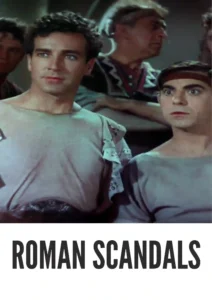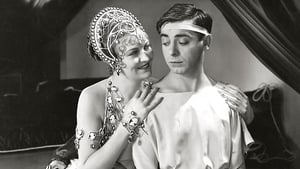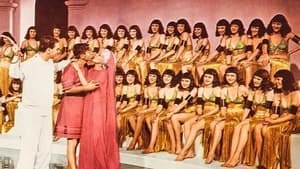Contact: info@alwanfilm.com
Video Sources 0 Views

Synopsis
Review: Roman Scandals 1933 Colorized – A Delightful Musical Comedy Extravaganza

Introduction
In the annals of classic Hollywood cinema, few films encapsulate the spirit of the 1930s as vibrantly as “Roman Scandals 1933.” Directed by Frank Tuttle and starring the inimitable Eddie Cantor, this musical comedy offers a rollicking ride through time and space, blending contemporary satire with ancient Roman spectacle. In this article, we will explore the joyous, irreverent world of “Roman Scandals 1933,” delving into its storied production, iconic performances, and lasting legacy.
Check The Full Colorized Movies List
Check Our Colorized Movies Trailer Channel
Understanding Roman Scandals 1933 Colorized: Director, Cast, and Genre
“Roman Scandals 1933” is a quintessential example of the pre-Code Hollywood musical, a genre characterized by its unrestrained humor, vibrant performances, and innovative musical numbers. The film was helmed by Frank Tuttle, a director known for his versatility and flair for comedy.
Eddie Cantor, a beloved vaudeville star and radio personality, shines in the lead role as Eddie, a hapless small-town boy who finds himself transported back to ancient Rome. The film’s stellar cast includes Gloria Stuart as the love interest, Ruth Etting as a captivating performer, and David Manners as a dashing Roman hero.
Exploring the World of Roman Scandals 1933 Colorized: Plot and Characters
“Roman Scandals 1933” begins in the fictional town of West Rome, Oklahoma, where Eddie works as a humble delivery boy. After a series of comedic mishaps, Eddie is knocked unconscious and dreams of being transported to ancient Rome. Here, he finds himself embroiled in a series of outrageous escapades, from thwarting corrupt politicians to rescuing damsels in distress.
Eddie’s journey is populated with a host of colorful characters, each contributing to the film’s lively atmosphere. Gloria Stuart plays Princess Sylvia, an aristocratic beauty who captures Eddie’s heart. Ruth Etting delivers a show-stopping performance as Olga, a sultry singer. The film’s ensemble cast brings the ancient world to life with charm and humor, creating a delightful pastiche of Roman history and contemporary satire.
The Art of Musical Comedy in Roman Scandals 1933 Colorized
Musical comedy, a genre blending humor and song, reached new heights in the 1930s, and “Roman Scandals 1933” stands as a shining example. The film features an array of memorable musical numbers, choreographed by the legendary Busby Berkeley. Berkeley’s intricate, kaleidoscopic dance routines add a layer of visual splendor, transforming the film into a feast for the eyes and ears.
The film’s musical score, composed by Alfred Newman, includes catchy tunes and witty lyrics that capture the playful spirit of the era. Eddie Cantor’s energetic performances, combined with Berkeley’s choreography, create a series of show-stopping moments that remain iconic in the annals of film history.
The Production Design of Roman Scandals 1933 Colorized
“Roman Scandals 1933” boasts lavish production design, transporting viewers from Depression-era America to the opulent world of ancient Rome. The film’s sets, designed by the acclaimed art director Richard Day, are a marvel of creativity and craftsmanship. From grandiose palaces to bustling marketplaces, each set is meticulously crafted to evoke the splendor and decadence of Rome.
The film’s costumes, designed by the legendary Travis Banton, further enhance the visual spectacle. Banton’s creations range from elaborate Roman togas to glamorous showgirl outfits, adding a touch of Hollywood glamour to the ancient setting. The attention to detail in the production design contributes to the film’s immersive, fantastical atmosphere.
Early Musical Films: A Brief History
The early 1930s marked a golden age for musical films, with Hollywood studios investing heavily in productions that combined song, dance, and storytelling. This era saw the rise of iconic stars like Fred Astaire, Ginger Rogers, and Busby Berkeley, whose innovative choreography revolutionized the genre.
Musical films of this period often featured elaborate production numbers, sophisticated comedy, and a sense of escapism that resonated with audiences during the Great Depression. “Roman Scandals 1933” exemplifies the creative energy and ambition of early musical cinema, offering a blend of humor, romance, and visual spectacle.
Roman Scandals 1933 and Its Significance
“Roman Scandals 1933” holds a special place in film history, both as a showcase for Eddie Cantor’s comedic talents and as a milestone in the evolution of the musical genre. The film’s seamless integration of comedy and musical performance set a standard for future productions, influencing the trajectory of Hollywood musicals.
The film also reflects the cultural and social context of the 1930s, with its satirical take on politics, society, and history. Through its humorous portrayal of ancient Rome, “Roman Scandals 1933” offers a lens through which to view contemporary issues, providing a timeless commentary on the human condition.
The Debate Over Pre-Code Hollywood
“Roman Scandals 1933” was produced during the pre-Code era, a period in Hollywood history characterized by a relative lack of censorship. Films of this era often featured risqué humor, provocative themes, and daring performances that would later be curtailed by the enforcement of the Hays Code in 1934.
The debate over pre-Code films centers on their artistic freedom and cultural impact. While some critics argue that these films pushed boundaries and challenged social norms, others contend that the lack of regulation led to content that was sometimes exploitative or insensitive. “Roman Scandals 1933” stands as a testament to the creative possibilities of the pre-Code era, blending humor and satire with bold storytelling.
Examining Roman Scandals 1933 Colorized as a Musical Comedy
As a musical comedy, “Roman Scandals 1933” excels in blending humor with song and dance, creating a delightful and entertaining experience for audiences. The film’s witty dialogue, slapstick humor, and energetic musical numbers combine to create a fast-paced, joyous romp through history.
Eddie Cantor’s comedic timing and charismatic presence anchor the film, making his character’s escapades both engaging and endearing. The supporting cast, including Gloria Stuart and Ruth Etting, add depth and charm to the narrative, enhancing the film’s overall appeal.
Influence and Legacy: Roman Scandals 1933 Colorized’s Impact on Cinema
“Roman Scandals 1933” has left a lasting legacy in the world of musical cinema, influencing subsequent generations of filmmakers and performers. The film’s innovative choreography, memorable musical numbers, and comedic genius have inspired countless productions, cementing its place in the pantheon of classic Hollywood musicals.
The influence of “Roman Scandals 1933” can be seen in the work of later musical comedies, from the elaborate production numbers of MGM musicals to the satirical humor of Mel Brooks. The film’s blend of historical parody and contemporary satire continues to resonate with audiences, highlighting the enduring appeal of its creative vision.
Director’s Cinematic Legacy: Beyond Roman Scandals 1933 Colorized
Frank Tuttle, the director of “Roman Scandals 1933,” enjoyed a prolific career in Hollywood, directing a wide range of films across various genres. Tuttle’s versatility and skill as a filmmaker are evident in his ability to seamlessly blend comedy, drama, and musical elements in his work.
Beyond “Roman Scandals 1933,” Tuttle’s filmography includes notable titles such as “This Gun for Hire,” a seminal film noir, and “The Glass Key,” an adaptation of a Dashiell Hammett novel. Tuttle’s contributions to the industry reflect his adaptability and talent, making him a respected figure in Hollywood history.
Themes Explored in Roman Scandals 1933 Colorized
“Roman Scandals 1933” explores themes of social satire, historical parody, and the quest for justice, all wrapped in a humorous and entertaining package. The film’s playful take on ancient Rome serves as a vehicle for commentary on contemporary issues, from political corruption to societal inequality.
At its heart, the film celebrates the power of humor and imagination to transcend time and space, offering a timeless message about the resilience of the human spirit. Through Eddie’s journey, “Roman Scandals 1933” reminds audiences of the enduring importance of laughter and creativity in the face of adversity.
Reception and Controversy Surrounding Roman Scandals 1933 Colorized
Upon its release, “Roman Scandals 1933” received a warm reception from audiences and critics alike, who praised its humor, musical numbers, and Eddie Cantor’s performance. The film’s playful irreverence and visual splendor captured the imagination of viewers, cementing its status as a beloved classic.
However, the film also faced controversy for its pre-Code content, including risqué humor and provocative imagery. While these elements contributed to the film’s popularity, they also sparked debates about the boundaries of artistic expression and the role of censorship in Hollywood.
Where to Watch Roman Scandals 1933 Colorized Online
For those eager to experience the timeless charm of “Roman Scandals 1933,” the film is available on various streaming platforms and digital archives. Classic film enthusiasts can enjoy this musical comedy gem through services like Turner Classic Movies (TCM), Criterion Channel, or rental options on platforms like Amazon Prime and iTunes.
FAQs About Roman Scandals 1933 Colorized
Common queries surrounding “Roman Scandals 1933” range from its historical context to its cultural significance. By addressing these frequently asked questions, viewers can gain a deeper understanding of the film’s enduring appeal and impact.
Q: What is the significance of the film’s title?
A: The title “Roman Scandals” is a playful reference to both the setting of ancient Rome and the humorous, scandalous events that unfold within the narrative. It reflects the film’s blend of historical parody and contemporary satire.
Q: How does “Roman Scandals 1933” reflect the pre-Code era?
A: “Roman Scandals 1933” embodies the spirit of the pre-Code era with its unrestrained humor, risqué content, and bold storytelling. The film’s playful irreverence and provocative imagery are characteristic of the period before the enforcement of the Hays Code.
Q: What are some of the most memorable musical numbers in the film?
A: The film features several iconic musical numbers, including Eddie Cantor’s energetic performance of “Build a Little Home” and Ruth Etting’s sultry rendition of “No More Love.” Busby Berkeley’s choreographed sequences add a layer of visual spectacle, creating unforgettable moments in musical cinema.
Conclusion
In conclusion, “Roman Scandals 1933” stands as a testament to the creative energy and innovation of early Hollywood musicals. Directed by Frank Tuttle and starring the incomparable Eddie Cantor, the film blends humor, music, and satire to create a timeless cinematic experience. Whether viewed in its original format or through modern streaming platforms, “Roman Scandals 1933” continues to delight and inspire audiences with its joyous celebration of creativity and imagination. As we revisit this classic, we are reminded of the enduring power of laughter and the timeless appeal of Hollywood’s golden age.


















